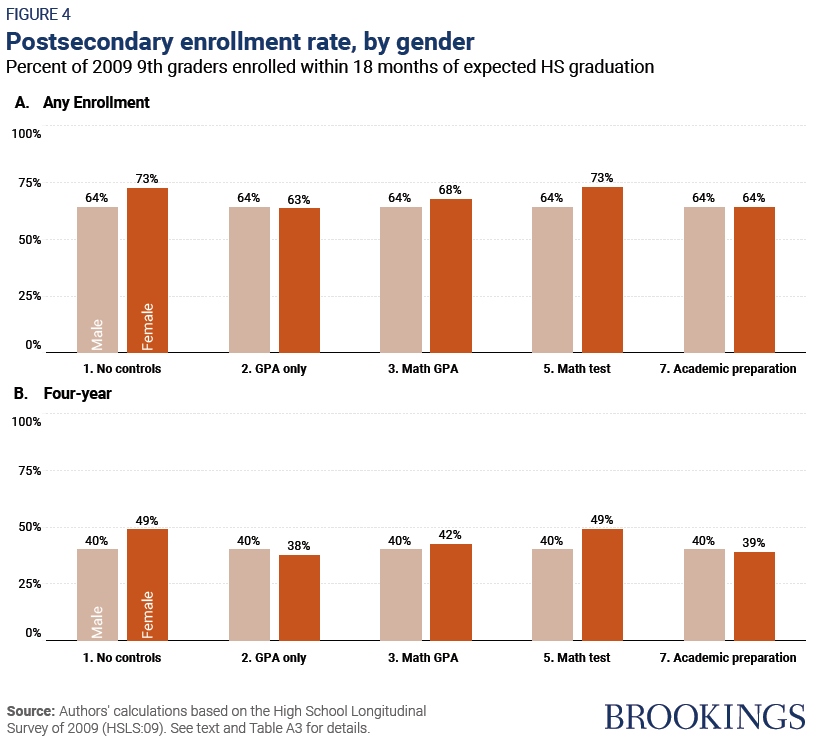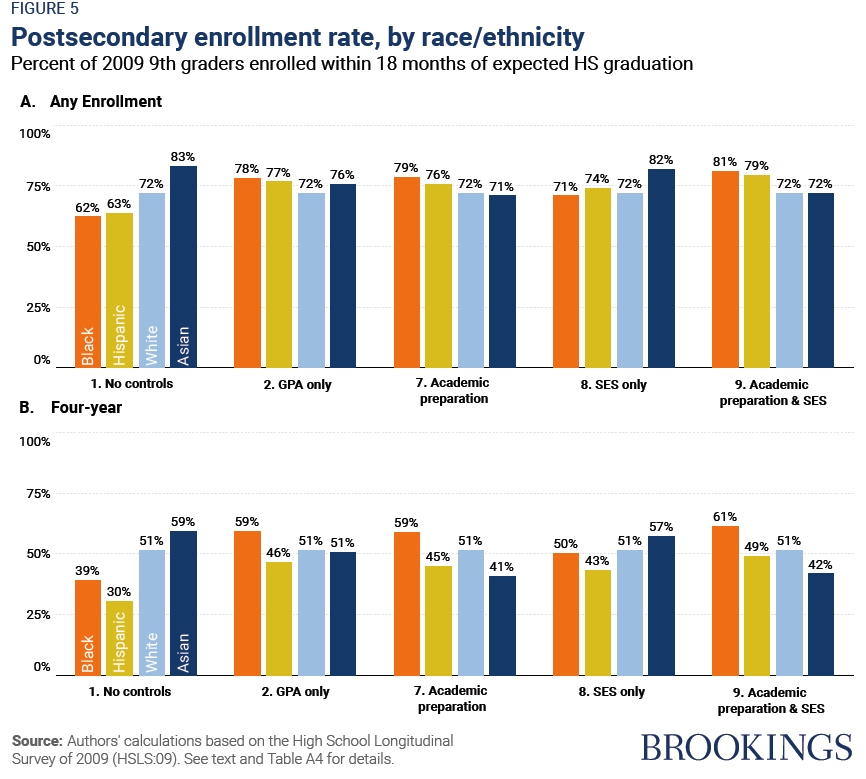Comments
- No comments found

There are large gaps in college attendance between men and women and across ethnic groups.
To what extent might these differences reflect academic preparation of students? Sarah Reber and Ember Smith provide some baseline information on these issues in “College Enrollment Disparities: Understanding the Role of Academic Preparation (January 2023, Center on Children and Families at Brookings). They point out:
In 2022, young men [age 25-29] were nine percentage points less likely to have a bachelor’s degree than young women (35% and 44%). … Disparities in bachelor’s degree attainment by race and ethnicity are large: 68% of Asian or Pacific Islander adults aged 25 to 29 have a bachelor’s degree, compared with 45% of white,
28% of Black, and 25% of Hispanic young adults.
But what do these gaps look like if one takes academic preparation into account. In the figure, the top set of bars shows the likelihood of men and women enrolling in college at all–including two-year and four-year colleges–while the second set of bars shows only the likelihood of enrolling in a four-year college. The “No Controls” shows the overall average for males and females. But notice that when you compare those with similar grade point averages or levels of academic preparation, the gap goes away.

The authors write: “Taken together, the results by gender suggest that most or all gender gaps in college enrollment
are explained by differences in academic preparation. However, … GPA explains essentially all, and math test score
explains none, of the gaps.”
What are the patterns by ethnicity? Again, the top row of bars shows all colleges, and the bottom row shows just four-year colleges. The “No controls” shows the overall averages for each group. The striking pattern is that on average, Asians are more likely to attend college. But if one adjusts for grade point average or for overall academic achievement, blacks become the most likely group to attend college. The final two sets of bars show an adjustment for “socioeconomic status,” which clearly reduces the differences across groups, and then a joint adjustment for socioeconomic status and academic preparation, which looks a lot like the adjustment just for academic adjustment alone.

These types of results are just descriptions of patterns in the data. They are not studies that dig into cause-and-effect relationships or offer policy recommendations. In addition, the grade point average or academic preparation of a high school student is partly about the performance of K-12 schools, but also about differences across families, peer groups, and neighborhoods. But in my reading, this evidence strongly suggests that college attendance gaps across men and women, or across ethnic groups, largely reflect the academic preparation of high school students.
Timothy Taylor is an American economist. He is managing editor of the Journal of Economic Perspectives, a quarterly academic journal produced at Macalester College and published by the American Economic Association. Taylor received his Bachelor of Arts degree from Haverford College and a master's degree in economics from Stanford University. At Stanford, he was winner of the award for excellent teaching in a large class (more than 30 students) given by the Associated Students of Stanford University. At Minnesota, he was named a Distinguished Lecturer by the Department of Economics and voted Teacher of the Year by the master's degree students at the Hubert H. Humphrey Institute of Public Affairs. Taylor has been a guest speaker for groups of teachers of high school economics, visiting diplomats from eastern Europe, talk-radio shows, and community groups. From 1989 to 1997, Professor Taylor wrote an economics opinion column for the San Jose Mercury-News. He has published multiple lectures on economics through The Teaching Company. With Rudolph Penner and Isabel Sawhill, he is co-author of Updating America's Social Contract (2000), whose first chapter provided an early radical centrist perspective, "An Agenda for the Radical Middle". Taylor is also the author of The Instant Economist: Everything You Need to Know About How the Economy Works, published by the Penguin Group in 2012. The fourth edition of Taylor's Principles of Economics textbook was published by Textbook Media in 2017.
Leave your comments
Post comment as a guest